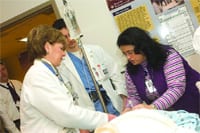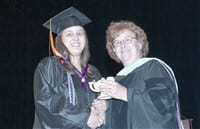Learning Curves This Specialist Works to Chart Courses for Health Care Providers in Training
Dr. Gladys Fernandez says there was no ‘a-ha moment,’ as they’re called, that led her to pursue a career in medicine, as there have been so many others who have chosen that path.
“I was just raised by parents who said, ‘we don’t care what you do … you just need to do something important with your life, where you will help people and make a difference,’” she told The Healthcare News, adding that she gravitated toward both the medical field and teaching — two realms that certainly met the criteria set by her parents.
And she has melded both interests into a job (or jobs, depending on how one looks at it) that make for a cluttered business card. It declares that she is assistant program director in Surgery, assistant professor of Surgery, and manager of the Simulation Program at Baystate Medical Center, where she has spent her entire career.
“I wear a lot of hats,” she said, adding that the sum of this figurative headgear is a position in which she creates some of those a-ha moments for others working their way into the medical field.
“People will say, “I did this because you taught me,’ or ‘I did this because I learned it with you,’” Fernandez, who practices what she calls ‘academic medicine,’ explained. “ And that’s priceless.”
In her position, Fernandez, who works most closely with the 30 or so surgical residents at Baystate, says she often gets to blend teaching with research, and such was the case in the development of artificial bowel tissue now used to help students learn how to perform intestinal anastomoses, or the sewing together of two ends of bowel tissue.
Called the Tactility P.1 Bowel, the product was developed by Baystate in conjunction with the Great Barrington-based Chamberlain Group, which, in addition to creation of surgical-training products, once handled special effects for movies that include The Matrix, Eraser, Starship Troopers, Judge Dredd, and Ghostbusters.
“We told them we needed help creating something that is realistic enough and appropriate so that we could teach residents something we feel they really needed in training,” said Fernandez. “Through a John Adams Innovation Grant, we were able to develop the tissue, a curriculum, and training DVDs. It’s been very exciting, and now we’re now starting a project for vascular anastomoses, which we haven’t named yet but will probably be called Tactility II.”
For this, the latest installment of its Today’s Physician series, The Healthcare News profiles a physician who specializes in creating learning experiences.
Stitch in Time
Fernandez said the process of teaching surgical residents has come a long a way in just a few decades.
Elaborating, she said that technology has created learning processes that would be considered much safer — and in most ways, more effective — than what was available years ago. And by technology, she meant everything from virtual-reality trainers to state-of-the-art simulators, or mannequins, to new products like the artificial bowel.
“Ten years ago, we used to learn on patients, and now, we do a lot of it through simulation and through structuring very safe educational environments,” she said, adding that the airline industry had a huge lead on the health care sector when it came to the use of simulators to train people, but the medical field is catching up.
Putting all the new technology to its highest and best use is just part of Fernandez’s broad job description. “I focus my efforts on curriculum development and implementation for all our physicians in training,” she explained, while quickly correcting herself. “For all our health care providers in training, because we have physician assistants and do some work with nurses. Our residents have to learn somehow, and someone has to structure the learning.”
Such structuring represents a dream job for Fernandez, who earned bachelor’s degrees in both Chemistry and Anthropology/Sociology at Florida International University. She graduated from the Tufts University School of Medicine in Boston, and conducted her general surgery residency at Baystate.
Like most surgeons, Fernandez said she doesn’t have anything that could be described as a ‘typical day.’ Duties might include everything from addressing matters with curriculum to grant writing; from developing abstracts for research projects to being the voice for a patient simulator who has just been told she has cancer. How the physician responds to her reactions is part of the training.
“The person can freak out and start crying, she can be in disbelief … they usually respond just like a patient, because the one doing the voice knows from experience what happens in the real clinical world,” she said. “With this kind of exercise, the residents or physician assistants can figure out the right thing to say, or learn the various ways to approach such situations before they face them in the real world.”
While working closely with the surgical residents, Fernandez manages Baystate’s simulation programs, which constitute a small piece of the training regimens for people in other residency programs, including pediatrics, gynecology, emergency medicine, radiology, and others.
The center, which opened in 1998 and was expanded in 2007, includes several dozen high-tech training devices, including high-fidelity patient simulators (mannequins), virtual-reality trainers, minimally invasive surgery trainers, and patient-safety-directed bench-top skills trainers.
The virtual-reality trainers, which have become a key component of surgical training in recent years, can be used to simulate such things as gallbladder removal, a colonoscopy, putting tubes in the chest to address fluid loss, and countless other types of procedures, she said.
Meanwhile, with the mannequins, residents can perform CPR, put the ‘patient’ on a ventilator, and work on those soft skills that are an important part of medicine.
“People learn not only what to say, but how to say it, and how to use laymen’s terms,” she continued. “A lot of physicians are good at explaining something as if they were speaking to another physician, but it’s another thing explaining it to a patient.”
When asked if there are ‘right’ and ‘wrong’ answers to questions and problems posed by the various types of simulators, Fernandez said yes, but added quickly that there are many, many ‘rights.’
“And one thing we teach our residents and other health care providers is that there are often several ways to get to the right end,” she said. “We give them the experience to make safe clinical decisions, knowing that there are a couple of ways to get to the same end point.”
Returning to the subject of artificial bowel tissue and that research project, Fernandez said it is designed to help students master more-traditional, or non-minimally-invasive, surgical techniques, something they don’t get significant practice with in the wake of new technology and, more specifically, laparoscopy. And it’s just another example of how residents and others are prepared for that real world they’ll enter.
“That’s a necessary tool for any surgeon to have in his or her pocket,” she said of the hand-sewn anastomoses. “And it’s just one many they’ll need.”
A Cut Above
Fernandez told The Healthcare News that her current position blends teaching and research in a way that brings rewards that are different from those that result from direct work with patients, but equally gratifying.
“There is a void from not being in the operating room,” she admitted. “But the feeling that I have when I train 20 people who are going to go and take care of thousands of people, it’s very gratifying. It’s very valuable work … I’m making a difference, in my mind.”
And she knows that from all those ‘a-ha moments’ she helps create.



Comments are closed.